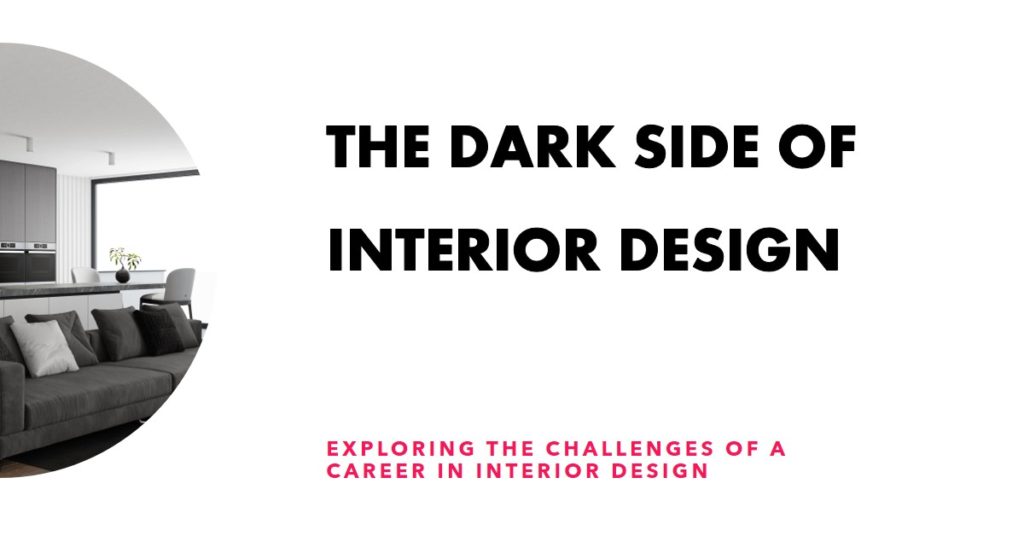
Table of Contents
- Introduction
- 1. High Client Expectations: Meeting Unreasonable Demands
- 2. Financial Instability: The Unpredictability of Income
- 3. Intense Competition: Standing Out in a Crowded Market
- 4. Physical and Mental Exhaustion: The Toll on Well-being
- 5. Client Relationships: Navigating Personal Dynamics
- 6. Constant Learning: Keeping Up with Trends and Technologies
- 7. Project Management: Balancing Creativity and Logistics
- 8. Legal and Regulatory Compliance: Navigating Bureaucracy
- 9. Work-Life Balance: Juggling Personal and Professional Life
- Conclusion: Embracing the Challenges
Introduction
Embarking on a career in interior design may appear glamorous and creatively fulfilling. However, beneath the surface lies a myriad of challenges that can be overwhelming. Aspiring designers should be aware of these potential downsides to prepare adequately and manage their expectations. This blog post will delve into the less glamorous aspects of an interior design career, offering a comprehensive understanding of the obstacles one might face.
1. High Client Expectations: Meeting Unreasonable Demands
One of the most significant challenges in interior design is managing client expectations. Clients often have a vision for their spaces that might not align with practical constraints. This disparity can lead to frustration and conflict.
Designers frequently find themselves in the position of having to temper clients’ dreams with reality. This requires not only excellent communication skills but also a strong understanding of materials, costs, and timelines. Balancing client satisfaction with feasibility is a delicate act that can be stressful and time-consuming.
2. Financial Instability: The Unpredictability of Income
Financial instability is a common issue in creative careers, and interior design is no exception. Many designers work as freelancers or run their own businesses, leading to fluctuations in income. This unpredictability can make financial planning difficult and add stress to an already demanding job.
Additionally, projects can be delayed or canceled, leading to further financial uncertainty. Designers must constantly market themselves to secure a steady stream of clients, which can be both time-consuming and exhausting. The feast-or-famine nature of the industry requires a solid financial strategy and a robust savings plan to weather the lean periods.
3. Intense Competition: Standing Out in a Crowded Market
The interior design industry is highly competitive. With many talented designers vying for the same clients, establishing a unique presence can be challenging. This intense competition can lead to lower rates as designers undercut each other to secure jobs, which can affect overall earnings and industry standards.
Moreover, the rise of online design services and DIY platforms has increased competition, making it harder for professionals to differentiate themselves. To stand out, designers must continually innovate and find ways to highlight their unique style and expertise, which requires a constant investment of time and resources.
4. Physical and Mental Exhaustion: The Toll on Well-being
Interior design is not just about creativity; it also involves a significant amount of physical labor and mental exertion. From sourcing materials to supervising installations, the job can be physically demanding. Long hours and tight deadlines add to the stress, often leading to burnout.
The mental strain of constantly coming up with new ideas and solutions can be taxing. Designers need to maintain their creative spark while managing multiple projects, which can lead to exhaustion. Self-care and time management strategies are crucial to sustaining long-term well-being in this field.
5. Client Relationships: Navigating Personal Dynamics
Building and maintaining client relationships is a critical aspect of an interior design career. However, this can be fraught with difficulties. Clients can be demanding, indecisive, or have unrealistic expectations, making the designer’s job more challenging.
Effective communication is key, but even the best communicators can struggle with difficult clients. Navigating these personal dynamics requires patience, diplomacy, and sometimes, compromise. Developing these soft skills is essential, but it can also be emotionally draining.


6. Constant Learning: Keeping Up with Trends and Technologies
The interior design industry is dynamic, with trends and technologies constantly evolving. Designers must stay updated with the latest materials, tools, and software to remain competitive. This continuous learning curve can be both exciting and exhausting.
Investing time in education and professional development is necessary but can be challenging to balance with ongoing projects. Designers must be adaptable and willing to embrace change to keep their skills relevant and their designs fresh. This perpetual need for growth can be overwhelming and requires a commitment to lifelong learning.
7. Project Management: Balancing Creativity and Logistics
A successful interior design project requires more than just a keen eye for aesthetics; it also demands strong project management skills. Designers must oversee budgets, timelines, and coordination among various contractors and suppliers. Balancing these logistical aspects with the creative side of the job can be daunting.
Mistakes or delays in project management can lead to significant setbacks and increased costs. Designers must be detail-oriented and proactive, anticipating potential issues before they arise. This dual role of creative visionary and meticulous planner can be stressful and requires a diverse skill set.
8. Legal and Regulatory Compliance: Navigating Bureaucracy
Interior designers must navigate a complex landscape of legal and regulatory requirements. This includes building codes, safety regulations, and accessibility standards. Ensuring compliance can be time-consuming and requires a thorough understanding of relevant laws and regulations.
Failing to comply with these requirements can lead to legal issues, project delays, and additional costs. Designers must stay informed about changes in regulations and ensure that all aspects of their projects adhere to legal standards. This added layer of responsibility can be burdensome and requires careful attention to detail.
9. Work-Life Balance: Juggling Personal and Professional Life
Achieving a healthy work-life balance is challenging in any profession, but it can be particularly difficult in interior design. The demands of meeting client expectations, managing projects, and staying current with industry trends often require long hours and weekend work.
This can take a toll on personal relationships and overall well-being. Designers must establish boundaries and prioritize self-care to avoid burnout. Finding this balance is crucial for sustaining a long and fulfilling career in interior design but can be difficult to achieve consistently.
Conclusion: Embracing the Challenges
While a career in interior design offers many rewards, it is essential to acknowledge and prepare for its downsides. High client expectations, financial instability, intense competition, physical and mental exhaustion, challenging client relationships, constant learning, project management, legal compliance, and work-life balance are significant hurdles.
Understanding these challenges can help aspiring designers develop strategies to navigate them effectively. With the right approach, support, and resilience, it is possible to enjoy a successful and satisfying career in interior design, despite its inherent difficulties.



